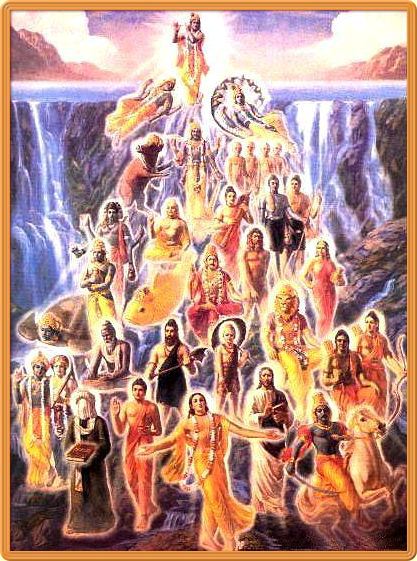
Krsna, God, exists in three principal forms (rupas)
svayam-rupa, tad-ekatma-rupa, and avesa-rupa.
Svayam-rupa
Svayam means "original." In this category there is only one person: Krsna. Originally God is one; no one is greater than or equal to Him. Krsna has no origin. He is the source of everything and the sum of everything. He is the original creator of all living entities and of the material and spiritual worlds. He is the source of all expansions of God. He is the shelter of everything and master of everyone. He is the supreme controller, and His spiritual body is eternal, full of bliss and knowledge. There is no difference between Krsna and His body, as there is for living entities in the material world.
Krsna is distinguished from all others because He possesses sixty-four qualities in full. Other manifestations of Krsna possess varying degrees of these qualities. The Nectar of Devotion clarifies: "Krsna has four more [qualities], which are not manifest even in the Narayana form of Godhead, what to speak of the demigods or living entities. They are as follows: (61) He is the performer of wonderful varieties of pastimes (especially His childhood pastimes). (62) He is surrounded by devotees endowed with wonderful love of Godhead. (63) He can attract all living entities all over the universes by playing on His flute. (64) He has a wonderful excellence of beauty which cannot be rivaled anywhere in the creation."
All Vedic literature directly or indirectly points to Lord Krsna. Krsna is the source of the Vedas, the knower of the Vedas, and the end of all veda (knowledge).
Tad-ekatma-rupa
This category consists of expansions and avataras (incarnations) of the Lord. They are extraordinary and unlimited. The chart lists only a few. An expansion is a form of the Lord residing in the spiritual realm; an avatara is a form of the Lord who comes to the material world. (See the side-bar "The Avataras.") Vedic literature refers to both expansions and avataras as amsa (plenary portions) and kala (portions of plenary portions). Amsas expand directly from the Lord, and kalas expand from amsas.
These expansions and avataras possess some of the qualities Lord Krsna possesses in full. They appear with bodily features and emotions different from Krsna's, and They carry out specific activities. They are uniquely named according to these qualifying characteristics.
Everything we experience in this world is created, sustained, or destroyed by one of these forms. The purpose of creation is to provide a learning field where we can awaken to our original relationship with Krsna and rejoin Him in His spiritual creation. The activities of the expansions and incarnations, like those of Krsna Himself, give us transcendental topics to hear and talk about, which clears our path out of the material entanglement.
Avesa-rupa
Also known as saktyavesa-avatara, this category has three divisions: bhagavad-avesa (divine absorption), saktyavesa (directly empowered), and vibhuti (indirectly empowered).
Servants of the Lord empowered with knowledge and strength make up this category. They can act almost like God in carrying out specific functions. There are unlimited numbers of empowered devotees; the chart lists some of them. Most are jivas, or minute souls, and not God Himself (visnu-tattva). Exceptions: Sesa Naga, Ananta, Kapila, and Rsabhadeva.
Vibhutis, or opulent things of this world, are also categorized as avesa-rupas of the Lord. They are indirectly empowered by God. Krsna explains that everything beautiful, opulent, and glorious in this world comes from Him. He gives an extensive list ofvibhutis in the tenth chapter of Bhagavad-gita. Srila Prabhupada comments: "Any glorious or beautiful existence should be understood to be but a fragmental manifestation of Krsna's opulence, whether it be in the spiritual or material world. Anything extraordinarily opulent should be considered to represent Krsna's opulence." (Bg. 10.41, Purport)
The Avataras
Purusa-avataras
Purusa means "controller." The purusa-avataras are the three supreme controllers of the material manifestations: Karanodakasayi Visnu, Garbhodakasayi Visnu, and Ksirodakasayi Visnu. Karanodakasayi Visnu creates unlimited universes. From Him comes a Garbhodakasayi Visnu for each universe. From Garbhodakasayi Visnu comes Brahma, the secondary material creator, as well as Ksirodakasayi Visnu, who enters every atom of each universe and is also known as the Supersoul, or Paramatma (below). Paramatma sits in the hearts of all living entities, giving direction to them in their material sojourn.
Lila-avataras
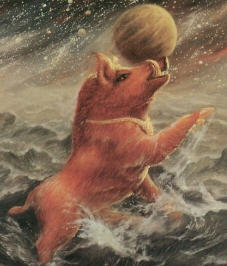
Lila-avataras are also known as kalpa-avataras. Lila means "pastimes," and a kalpa is a day of Brahma. These avataras appear in each day of Brahma (every 4.32 billion years). They respond to the desires of devotees and protect the universe. InCaitanya-caritamrta (Madhya 6.99), Srila Prabhupada elaborates: "A lila-avatara is an incarnation of the Lord who performs a variety of activities without making any special endeavor. He always has one pastime after another, all full of transcendental pleasure, and these pastimes are fully controlled by the Supreme Person. The Supreme Person is totally independent of all others in these pastimes."
Guna-avataras
Guna means "material qualities," of which there are three categories: passion, which generates the creation of the material manifestation; goodness, which maintains the material manifestation; and ignorance, which destroys the creation. Brahma (right) is in charge of creation, Visnu maintenance, and Siva destruction.
Lord Visnu is a direct expansion of Krsna and is therefore in the visnu-tattva category. Brahma is a post for managing the secondary material creation. The post ismost often filled by a highly qualified devotee of Krsna (jiva-tattva), but if no one is available, then Visnu will perform Brahma's duties. Siva is also a devotee of Lord Krsna. He possesses more of Krsna's qualities than ordinary souls, but less than Krsna or His expansions and incarnations. Siva is in a category of his own, called siva-tattva.
Manvantara-avataras
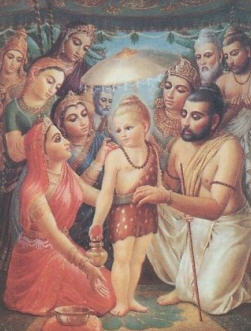
Manvantara means "the life span of Manu." Manus are rulers in the higher planetary systems, and they give direction to human society through scriptures. They live for seventy-one divya-yugas. A divya-yuga is the four yugas taken together. Thesemanvantara incarnations appear simultaneously with the
Manus and change as the Manus change. In Srimad-Bhagavatam (2.7.20), Srila Prabhupada explains, "The manvantara incarnation chastises all the miscreant rulers of different planets with as much power as that of the Supreme Personality of Godhead, who punishes the miscreants with His wheel weapon. The manvantara incarnations disseminate the transcendental glories of the Lord." The current manvantara-avatara is Lord Vamana (below). (Laghu-bhagavatamrta 4.16).
Yuga-avataras
Yuga means "age," and sometimes it is translated as "millennium." The term is used to refer to the calculation of cyclical time of the material creation. Satya-yuga is 1,728,000 years and is characterized by virtue, religion, and wisdom. Treta-yuga is 1,296,000 years, and vice is introduced. Dvapara-yuga is 864,000 years, and virtue and religion further decline. Kali-yuga (the current age) lasts 432,000 years and is full of vice and irreligion.
The yuga-avatara gives the yuga-dharma, or the religion for the specific age. (See the sidebar "The Incarnations for this Age.")
The Incarnations for this Age
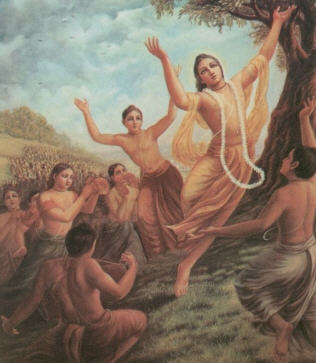
Although Sri Krsna Caitanya Mahaprabhu is the yuga-avatara, or the incarnation for this age, He is in fact neither an incarnation nor an expansion of Krsna. Rather, He is identical with svayam-rupa Krsna.
Giving special mercy to the people of this age, Krsna Himself has come in two forms: as Lord Caitanya Mahaprabhu and as His holy name, as in the maha-mantra Hare Krsna, Hare Krsna, Krsna Krsna, Hare Hare/ Hare Rama, Hare Rama, Rama Rama, Hare Hare.
Lord Caitanya is known as the most magnanimous incarnation because He freely delivers love of Krsna, the highest goal of life. To understand Krsna is difficult, but it has been made easy by the mercy of Lord Caitanya. He is also known as magnanimous because His mercy surpasses the bounds of mundane distinction of sex, race, caste, and so on. He made equally available to everyone the sublime process of attaining Krsna.
That process, the religion of this age, is chanting the Hare Krsna maha-mantra. As the yuga-avatara, Lord Caitanya appeared in this world five hundred years ago to teach us how to develop love of Krsna by chanting His names.
God as the Temple Deity
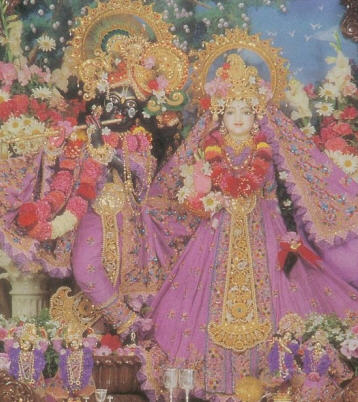
Krsna is accessible to us at all times through His deity manifestation. The deity, also known as the arca-murti ("form for worship"), comes to the world to bestow mercy on the devotees by allowing them to see Him face to face and serve Him directly. By seeing and serving the deity, devotees fix their minds on the form of the Lord. Vedic literature describes in detail how to worship the Lord in this world in His deity form.
Though the arca-murtis seem to be made of material elements such as clay, wood, metal, or stone, They are identical with the forms of the Lord in the spiritual world. These forms are in the vaibhava-vilasa category.
In Sri Caitanya-caritamrta (Madhya 20.217) Srila Prabhupada comments: "The deity in the temple, however, is visible to the material eyes of the devotee. It is not possible for one in material, conditioned life to see the spiritual form of the Lord. To bestow causeless mercy upon us, the Lord appears as the arca-murti so that we can see Him. . . . No one should consider the deity in the temple to be made of stone or wood. . . . Nor should anyone consider the Hare Krsna maha-mantra to be a material vibration. All these expansions of Krsna in the material world are simply demonstrations of the Lord's mercy and willingness to give facility to His devotees who are engaged in His devotional service within the material world."
The Identity Of Narayana
ALTHOUGH Lord Narayana does not appear in the chart, He's there. Srila Prabhupada uses the name Narayana to refer to any four-handed Visnu form, but he also uses the name to refer to a specific expansion of Krsna, with His own spiritual planet. Prabhupada calls Narayana the Lord of Vaikuntha. He says that Narayana is at the center of the catur-vyuha (They surround Him). He also explains that Narayana expands from Sankarsana of the catur-vyuha. Finally, Prabhupada refers to the purusa-avataras (the three Visnus involved in the creation) as the Narayana purusa-avataras. So the name Narayana can refer to many forms of the Lord.
Vilasa Expansions
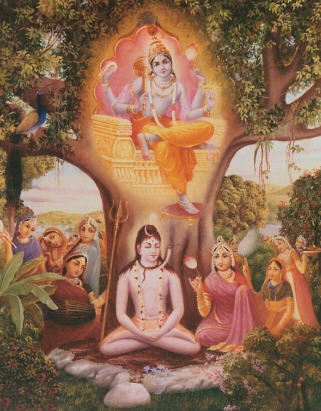
The first four expansions in the vilasa category (prabhava-vilasa) originate from Lord Balarama (vaibhava-prakasa). Prabhava manifestations are fully potent; vaibhava manifestations are partially potent. The four expansions Vasudeva, Sankarsana, Pradyumna, and Aniruddha are known as the catur-vyuha. Catur means "four," and vyuha means "guard" or "arms." These forms have four arms, and They guard the four directions of the material world. They reside in the spiritual world. Srila Prabhupada refers to Them as the aides-de-camp of Lord Krsna.
(1) Vasudeva, the first expansion, is the presiding deity of consciousness and the cause of the brahmajyoti effulgence.
(2) Sankarsana comes from Vasudeva and is the presiding deity of false ego. He is the source of Karanodakasayi Visnu. Sankarsana is known as the integrating and disintegrating power of God. In other words, He maintains the law of gravity and oversees the destruction of the universe.
(3) Pradyumna comes from Sankarsana and is the presiding deity of intelligence. He is responsible for universal growth and maintenance. From Pradyumna comes Garbhodakasayi Visnu.
(4) Aniruddha, who comes from Pradyumna, is the presiding deity of the mind and the source of Ksirodakasayi Visnu.
Srila Prabhupada explains: "The Lord in His different features (Vasudeva, Aniruddha, Pradyumna, and Sankarsana) maintains both the gross and subtle material elements of this world. As mentioned in Bhagavad-gita, the gross material elements are earth, water, fire, air, and ether, and the subtle material elements are mind, intelligence, and ego. All of them are controlled by the Supreme Personality of Godhead as Vasudeva, Sankarsana, Pradyumna, and Aniruddha. . . . Lord Krsna, by His quadruple expansion (Vasudeva, Sankarsana, Pradyumna and Aniruddha), is the Lord of psychic action namely thinking, feeling, willing, and acting." (Srimad-Bhagavatam 4.24.35-36, Purport)
From these first four expansions come other catur-vyuhas, known as vaibhava-vilasa. The months of the year and the markings of tilaka are named for these vaibhava-vilasa manifestations.
